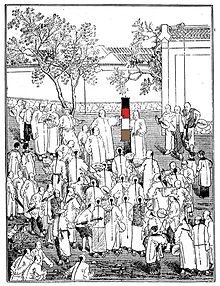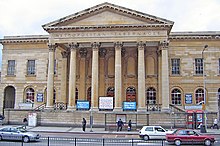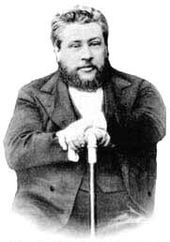Charles Spurgeon
Charles Haddon Spurgeon | |
|---|---|
 | |
| Born | June 19, 1834 |
| Died | January 31, 1892 (aged 57) |
| Nationality | British |
| Occupation(s) | Pastor, author |
| Spouse | Susannah Spurgeon |
| Children | Charles & Thomas Spurgeon (twins) (1856) |
| Parent(s) | John and Eliza Spurgeon |
Charles Haddon (C.H.) Spurgeon (19 June 1834 – 31 January 1892)[1] was a British Baptist preacher. People still know him as the "Prince of Preachers".[2] In his lifetime, Spurgeon preached to about 10 million people.[3] Spurgeon would often preach 10 times a week at different places. His sermons have been translated into many languages. Today, there are more writings and books by Spurgeon than by any other Christian writer.[4]
Spurgeon was the pastor of the Metropolitan Tabernacle in London for 38 years. Under the previous pastor, Dr John Rippon, it became the largest Baptist congregation in Great Britain. [5] He was part of several controversies with the Baptist Union of Great Britain, and later had to leave that denomination.[6] Throughout his life, Spurgeon suffered from depression and other mental illnesses. In 1857, he started a charity organisation called Spurgeon's which works all over the world.[7]
Biography
Family background and childhood
His family
Charles Spurgeon was born on 19 June 1834, in Kelvedon, in the English county of Essex. He was the eldest child of Eliza Jarvis and John Spurgeon.[8] His mother Eliza was born in nearby Belchamp Otten on 3 May 1815.[8] She was about 19-years-old when Spurgeon was born.[8] His father John Spurgeon, born in Clare, Suffolk on 15 July 1810, was about 24-years-old.[8] There were 17 children in Spurgeon's family, but nine of them died when they were babies.[8]
Interests

When he was six, Spurgeon read The Pilgrim's Progress. He read that book over 100 times in his life.[4] Spurgeon was also very good at mathematics. As a young boy, he would read the Scriptures at family worship. He memorised many hymns as a child, and would use many of them in his sermons later in life.[9]
Spirituality
As an early teenager, he was very intelligent, but was also fearful and doubting. By the influence of his father and grandfather, Spurgeon was kept from most normal sins. As a child, he thought that he was a good person. But he later said that, "Day and night God's hand was heavy on me."[9] He read the whole Bible, but he thought that it was threatening him, rather than promising him good things. As he got older, these things weighed on his conscience.[9]
On 6 January 1850, when he was 15, a snow storm made him seek shelter in a Primitive Methodist chapel in Colchester.[10] While he was there, a worker there said to him, "Young man, you look very miserable."[11] Spurgeon knew this, and he believed now that only God could heal him. The worker, seeing his need, replied, "Young man, look to Jesus Christ! Look! Look! Look! You have nothin' to do but to look and live."[11]
Within moments, he was converted to Christianity,[10] or as he said: "God opened his heart to the Salvation message."[12] He later said that, "I thought I could dance all the way home." On 3 May 1850, he was baptised in the River Lark, at Isleham. Later that year, his family moved to Cambridge.
Early adulthood
Beginnings
He preached his first sermon in the winter of 1850–51. At that time, he was made the pastor of the Waterbeach Baptist Chapel in Cambridgeshire.[13] His preaching was thought to be very good. In 1853, he authored his first written work: a Gospel tract.[14]
New Park Street Chapel
In April 1854, aged 19 and after he had preached for three months, Spurgeon became the pastor of the New Park Street Chapel in London.[13] At that time, it was the largest Baptist congregation in the city. Within months of Spurgeon being the pastor there, he became very famous. Even before he was 20, Spurgeon had preached over 600 times.[4] His sermons were published every week, and many people read them.[13][15] While he was at the New Park Street Chapel, Spurgeon became friends with James Hudson Taylor.[16] Taylor was the man who started the China Inland Mission.
The way Spurgeon preached was not new, but it was easy to understand. When he would read and teach the Bible in his messages, many people would think about what Jesus had said. Because the church congregation became too large for their building, they had to move to Exeter Hall, then to Surrey Music Hall, and later to the Metropolitan Tabernacle.[17] By the age of 22, he was a very popular preacher.[18] He would preach to more than 10,000 people at a time.[19] Even before the microphone was invented, he spoke to an audience of almost 24,000 at the Crystal Palace.[20]
On 8 January 1856, Spurgeon got married to Susannah Spurgeon.[21] By the age of 33, she had to stay home because of her disabilities.[4] They had twin sons, Charles and Thomas.[21]
Tragedy

While he was preaching on 19 October 1856, there was a tragedy. A group of men yelled "Fire!"[22] This made many people panic and run for the exits. It was later found out that seven people died after being trampled to death.[22] Spurgeon was hurt emotionally by the actions of these men, and it had a large influence on his life. He had depression for many years. He later said that he cried for no reason, but still his ministry went on.
Middle life

On 18 March 1861, the church moved to their newly-built Metropolitan Tabernacle, at Elephant-and-Castle in London. The building could hold from five to six thousand people, and was like a modern-day "megachurch".[23] Spurgeon read many books, up to six a week.[4]
Spurgeon liked singing hymns and wrote several of them. He published a book of well-known hymns for use at his church. There was no pipe organ or other instruments in his church; the hymns were always sang unaccompanied. Spurgeon never called people to come forward after his sermons, which is a custom of many evangelical preachers, who like to talk to the people who have been moved in their faith by the preaching. Spurgeon would say that anyone could meet him on Monday to talk about Christ.[24] There was always someone at his door the next day. He preached there until his death 31 years later.
When the missionary David Livingstone died in 1873, a copy of Spurgeon's sermon, "Accidents, Not Punishments", was found among his belongings.[25] There was a comment at the top of the first page that read, "Very good, D.L." Livingstone carried the sermon with him when he travelled to Africa, but it was given back to Spurgeon. Spurgeon had given the message on Sunday, 8 September 1861, at the Metropolitan Tabernacle, in Newington, London. He had preached it because of two disasters that happened close to his house. On Sunday, 25 August 1861, there was a tragic accident between two trains in the Clayton Tunnel between London and Brighton. 23 people died from this crash and the crash also injured hundreds.[26] About two weeks later, on Monday, 2 September another train wreck in North London that made 15 more people die.
Final years and death

Spurgeon's wife was often too sick to leave their home to hear him preach. Near the end of his life, he had poor health with rheumatism, gout, and Bright's disease. He died near Nice in France, on 31 January 1892. Spurgeon's wife and sons lived longer than him. His body is buried in a tomb in London.[27]
Controversies
Baptist Union controversies
Around the end of Spurgeon's life, he was part of many conflicts in the Baptist Union of Great Britain (BUGB).[28] Spurgeon later left the Baptist Union.[6] Even after Spurgeon's death, there were such controversies there, such as the talk over whether or not the Baptist Union should be allowed to meet in the Metropolitan Tabernacle. Spurgeon's son, Thomas, who was the co-pastor of the Metropolitan Tabernacle with Archibald G. Brown, said that, "The Baptist Union almost killed my father." "Yes," replied someone at BUGB, "and your father almost killed the Baptist Union."[29]
Downgrade controversy
A controversy with Baptists started in 1887 when Spurgeon wrote what was later called the "Downgrade Controversy." It got that name when Spurgeon used word "Downgrade" when talking about how other Baptists looked at the Bible.[30] Spurgeon meant that things such as Charles Darwin's theory of evolution were making the Baptist Union weak.
Baptismal regeneration
The "baptismal regeneration" controversy was started by a sermon in the Metropolitan Tabernacle on 5 June 1864.[28] That was when Spurgeon spoke to Anglican Christian leaders who supported infant baptism.[31] The sermon is 16 pages long, so it took around an hour for Spurgeon to preach it.[28] Over 350,000 copies of this sermon were sold.[32] However, Spurgeon did work with Anglicans, as well as people from other denominations all his life.
Spurgeon's ministries
Spurgeon's
The Stockwell Orphanage was an orphanage started by Spurgeon for boys in 1867, and for girls in 1879. It was open until London was bombed in the Second World War.[33] It later turned into Spurgeon's Child Care (and then into Spurgeon's). It is now mainly in England, but has international projects in Mexico, Africa and Eastern Europe.[7]
Spurgeon's College
Spurgeon's College is a theological institute in London. Spurgeon started it in 1857. Spurgeon's College is a member of the Baptist Union.[34]
Spurgeon library
In 1906, William Jewell College in Liberty, Missouri paid £500 ($2500) for most of the Spurgeon library.[35] The Spurgeon library had around 5,100 books in it at the time. In 2006, the whole library was sold to the Midwestern Baptist Theological Seminary.[35] Some of Spurgeon's sermon notes are at Samford University in Birmingham, Alabama.[36]
Selected works by Charles Spurgeon

- All of Grace : ISBN 1-60206-436-9
- Chequebook of the Bank of Faith : ISBN 1-85792-221-2
- C. H. Spurgeon’s Autobiography : ISBN 0-85151-076-0
- God Promises You : ISBN 0-88368-459-4
- Lectures to My Students : ISBN 0-310-32911-6
- Morning & Evening : ISBN 1-84550-014-8
- Power in Prayer : ISBN 0-88368-441-1
- Soul Winner, The : ISBN 1-60206-770-8
- Spurgeon's Sermon Notes : ISBN 0-8254-3768-7
- Treasury of David, The : ISBN 0-8254-3683-4
- Word and Spirit : ISBN 0-85234-545-3
- Wordless Book, The
His works have been translated into many languages. He also made many volumes of commentaries, sayings, and other types of literature.[37]
Related pages
References
- ↑ "TIMELINE of Charles Spurgeon". Archived from the original on 2 April 2008. Retrieved 2008-06-07.
- ↑ ""Prince of Preachers" on CharlesSpurgeon.net". Retrieved 2008-05-23.
- ↑ "Bath Road Baptist Church". Retrieved 2008-06-26.
- ↑ 4.0 4.1 4.2 4.3 4.4 "Did You Know?". Retrieved 2008-06-16.
- ↑ "History of the Tabernacle". Retrieved 2008-06-26.
- ↑ 6.0 6.1 "The Greatest Victorian Preacher". Retrieved 2008-06-06.
- ↑ 7.0 7.1 "Welcome to Spurgeons". Retrieved 2008-06-07.
- ↑ 8.0 8.1 8.2 8.3 8.4 "The Spurgeon Country: 1465-1769". Retrieved 2008-06-17.
- ↑ 9.0 9.1 9.2 "The Search for God". Retrieved 2008-06-17.
- ↑ 10.0 10.1 "Charles Spurgeon's Conversion". Archived from the original on 29 January 2009. Retrieved 2008-06-07.
- ↑ 11.0 11.1 "The Personal Testimony of Charles Spurgeon". Retrieved 2008-06-18.
- ↑ "Benny Hinn Ministries on Charles Spurgeon". Retrieved 2008-06-13.
- ↑ 13.0 13.1 13.2 Bradstock (2001), p 387–388
- ↑ "Charles Spurgeon: A biography". Retrieved 2008-06-07.
- ↑ "C. H. Spurgeon at Victorianweb.org". Retrieved 2008-05-23.
- ↑ "Day 4 London. Canterbury Excursion". Retrieved 2008-06-24.
- ↑ "About Charles Spurgeon". Retrieved 2008-05-23.
- ↑ "C.H. Spurgeon at MountZion.org". Retrieved 2008-06-07.
- ↑ Drummond (1992), p 342
- ↑ Patricia S. Kruppa (1982), p 97
- ↑ 21.0 21.1 "Charles Spurgeon: A biography, Page 2". Retrieved 2008-06-16.
- ↑ 22.0 22.1 "The Religious Affiliation of Charles Spurgeon". Retrieved 2008-05-28.
- ↑ "The Power of Prayer in a Believer's Life". Retrieved 2008-06-06.
- ↑ "Background and story of alter calls". Retrieved 2008-05-23.
- ↑ "Accidents, Not Punishments". Retrieved 2008-05-23.
- ↑ "The story of the Clayton Tunnel Accident". Retrieved 2008-07-17.
- ↑ "The tomb of C. H. Spurgeon and other places in London". Archived from the original on 1 March 2005. Retrieved 2008-05-27.
- ↑ 28.0 28.1 28.2 "Two Great Controversies". Retrieved 2008-06-16.
- ↑ Drummond (1992), p 719
- ↑ "The Down Grade Controversy". Retrieved 2008-06-06.
- ↑ "Baptismal Regeneration". Retrieved 2008-06-07.
- ↑ "Charles Haddon Spurgeon: A Brief Biography". Retrieved 2008-06-07.
- ↑ "History of the Stockwell Orphanage". Retrieved 2008-05-28.
- ↑ "BAPTIST COLLEGES". Retrieved 2008-06-07.
- ↑ 35.0 35.1 "Spurgeon's personal library". Retrieved 2008-05-28.
- ↑ "The library of Samford University". Retrieved 2008-05-28.
- ↑ "Spurgeon's writings". Retrieved 2008-06-11.
Bibliography
- Bradstock, Andrew (2001). "Spurgeon, Charles Haddon". In Powell, Powell and Blakeley (ed.). Biographical dictionary of literary influences: the nineteenth century, 1800-1914. Greenwood Publishing Group. ISBN 9780313304224.
- Drummond, Lewis A. (1992). Spurgeon: prince of preachers. Kregel Publications. ISBN 9780825424724.
- Kruppa, Patricia S. (1982). Charles Haddon Spurgeon: a preacher's progress. Garland Publishing. ISBN 9780824051587.
Other websites
- More information on Charles Spurgeon
- Spurgeon Gems - Over 2,750 of Spurgeon's sermons in modern English
- Spurgeon's quotes and illustrations
Biographies
- Spurgeon's Biography - at Christian Biography Resources
- Spurgeon's Audio Biography
- "Charles Haddon Spurgeon, A Biography" - By W. Y. Fullerton
- "The Autobiography of Charles Spurgeon", vols. 1 and 2
